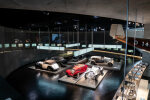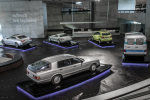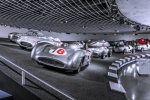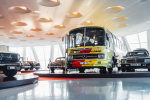Delete
Do you really want to delete the data record?
Download
Please wait a moment ...
Download
Please wait a moment ...
Download
Please wait a moment ...
Crop for shopping cart
Please wait a moment ...
Set as main picture
Do you want to set this media object as main picture?
-
Title
:
Legend 1 - Mercedes-Benz Museum
-
Caption
:
Legend 1: Pioneers – The Invention of the Automobile, 1886 - 1900 / Mercedes-Benz Museum. Any analysis of the most spectacular accomplishments of recent centuries will make frequent mention of a technical development which has changed the world from the ground up – the automobile. Working independently, Gottlieb Daimler and Carl Benz were the brains behind the first automobiles, which turned their wheels first in 1886. A combination of their brilliant inventions and the input of equally inspired partners such as Wilhelm Maybach helped to get the world on the move. Driving them forward, so to speak, was a highly explosive mixture of curiosity, a thirst for knowledge, and a sixth sense for technical feasibility. Together, these attributes opened the door to a succession of spectacular developments and allowed the long unfulfilled dream of individual mobility to finally become a reality. (Architektur: UNStudio van Berkel & Bos, Amsterdam; Museumsgestaltung: Prof. HG Merz, Stuttgart)
-
Date of Origin
:
30.11.2019
-
File size
:
6.75 MB
-
Rights Expiry Date
:
Unlimited
-
Title
:
Benz Patent Motor Car
-
Caption
:
Benz Patent Motor Car (1886); Location: Legend 1; Mercedes-Benz Museum / he Benz patent motor car was the world's first gasoline-engined automobile. Unlike Daimler's motorized carriage, the motor car - of which you see a replica here - formed an autonomous entity of chassis and engine. Carl Benz designed the car as a three-wheeler because he was not satisfied with the steering systems available for four-wheeled vehicles back in 1886. Cylinders 1; Displacement 58 cu in output 0.75 PS (0.55 kW) at engine speed 400/min; Top Speed 10 mph. (Architektur: UNStudio van Berkel & Bos, Amsterdam; Museumsgestaltung: Prof. HG Merz, Stuttgart)
-
Date of Origin
:
30.11.2019
-
File size
:
7.69 MB
-
Rights Expiry Date
:
Unlimited
-
Title
:
Mercedes-Simplex 40 PS
-
Caption
:
40 PS Mercedes-Simplex, Location: Legend 2, Mercedes-Benz Museum // his 40 PS Mercedes-Simplex is the oldest Mercedes still in existence. It was the direct successor to the 35 PS Mercedes designed by Wilhelm Maybach, which was the world’s first automobile of the modern age. The addition of the word “Simplex” related to the relative ease with which it handled for the period. Cylinders 4; Displacement 414 cu in Output 40 PS (29 kW) at engine speed 1100/min; Top speed 50 mph (Architektur: UNStudio van Berkel & Bos, Amsterdam; Museumsgestaltung: Prof. HG Merz, Stuttgart)
-
Date of Origin
:
30.11.2019
-
File size
:
7.26 MB
-
Rights Expiry Date
:
Unlimited
-
Title
:
Legend 3 - Mercedes-Benz Museum
-
Caption
:
Legend 3: Times of Change– Diesel and Supercharger, 1914 bis 1945 / Automobiles and airplanes are more closely related than it would appear at first. As early as 1888, Gottlieb Daimler had supplied the engine for an airship owned by Leipzig-based bookseller Friedrich Hermann Wölfert. Both Daimler-Motoren-Gesellschaft (DMG) and Benz & Cie. started developing engines specifically for aircraft even before World War I. During the course of the war, it became apparent that the engines did not supply sufficient power at high altitude due to the low air density. DMG solved this problem by developing the supercharger, which compressed the intake air, thus compensating for power loss. The company of course reasoned that whatever is good for the aircraft must be good for the automobile as well and after World War I, DMG also developed supercharged engines to boost the performance of automobiles. However, DMG and Benz & Cie., which merged to form Daimler-Benz AG in 1926, did not just want to prov
-
Date of Origin
:
08.12.2019
-
File size
:
7.71 MB
-
Rights Expiry Date
:
Unlimited
-
Title
:
Legend 4 - Mercedes-Benz Museum
-
Caption
:
Legend 4: Post-war Miracle – Form and Diversity, 1945 - 1960 / Mercedes-Benz Museum. The German economic miracle after World War II would have been inconceivable without vehicles from Daimler-Benz. The political fathers of the social market economy, the Deutschmark and the economic miracle had themselves chauffeured through the flourishing country in representative Mercedes-Benz sedans and convertibles. And anyone who benefited sufficiently from the economic miracle liked to demonstrate this with a Mercedes-Benz. Cars like the Adenauer Mercedes, the Gullwing or the Ponton – the basic model at the time – featured high up on the German citizens’ “wanted” list. The cars with the three-pointed star attracted buyers not only with attributes typical of the brand like quality, comfort, longevity, dynamism and representative elegance. Also, the developers in the Mercedes-Benz design studios had recognized the signs of change and ushered in a new era in form and design in Germany. The car incre
-
Date of Origin
:
21.01.2019
-
File size
:
18.79 MB
-
Rights Expiry Date
:
Unlimited
-
Title
:
Mercedes-Benz 300 SL Coupé "Gullwing"
-
Caption
:
Mercedes-Benz 300 SL Coupé "Gullwing", Legend 4, Mercedes-Benz Museum / The 300 SL production sports car presented in 1954 was based on the successful competition version of 1952. Its space frame weighed only 110 lbs. and was particularly sturdy, but did not permit the fitting of normal doors because of the high frame side members. With its characteristic upward-opening doors, the dream car of the 1950s popularly became known as the Gullwing. Cylinders 6; Displacement 182 cu in Output 215 PS (158 kW) at engine speed 5800/min; Top speed 162 mph; Production period 1954-1957. (Architektur: UNStudio van Berkel & Bos, Amsterdam; Museumsgestaltung: Prof. HG Merz, Stuttgart)
-
Date of Origin
:
21.01.2019
-
File size
:
19.23 MB
-
Rights Expiry Date
:
Unlimited
-
Title
:
Legend 5 - Mercedes-Benz Museum
-
Caption
:
Legend 5: Visionaries – Safety and the Environment, 1960 - 1982 / Mercedes-Benz Museum. In the development of new models, Mercedes-Benz engineers have by tradition accorded high priority to safety and the environment at all times. After the invention of the automobile in 1886, it was initially a question of giving the new means of transport operational reliability and easy handling. Once the motorized vehicle had established itself as a reliable means of transport, the engineers and technicians were able to devote themselves to new development fields which had been given little attention before. Among other things, this included the improvement of active and passive safety. Mercedes-Benz has always played a pioneering role in this field as well, thereby positively influencing automotive development throughout the world. A crucial era in this respect was the 1960s and 1970s. Men like the ingenious Mercedes-Benz design engineer Béla Barényi contributed substantially to the enhancement of
- Keywords :
-
Date of Origin
:
22.08.2018
-
File size
:
14.47 MB
-
Rights Expiry Date
:
Unlimited
-
Title
:
Mercedes-Benz 230 SL
-
Caption
:
Mercedes-Benz 230 SL, Legend 5, Mercedes-Benz Museum / The Mercedes-Benz 230 SL was the worlds first sports car with a sturdy passenger cell and crumple zones. Its outstanding feature is the extremely sturdy, concave shape of the removable hardtop. Popularly, the 230 SL was soon referred to only as the Pagoda – its hardtop reminded people of the roof shape of the Asian temples of the same name. Cylinders 6; Displacement 141 cu in Output 150 PS (110 kW) at engine speed 5500/min; Top speed 124 mph; Production period 1963-1967; Units produced 19831 (Architektur: UNStudio van Berkel & Bos, Amsterdam; Museumsgestaltung: Prof. HG Merz, Stuttgart)
-
Date of Origin
:
16.03.2019
-
File size
:
9.5 MB
-
Rights Expiry Date
:
Unlimited
-
Title
:
Legend 6 - Mercedes-Benz Museum
-
Caption
:
Legend 6: New Start - The Road to Emission-free Mobility, 1982 - today / Mercedes-Benz Museum. The 1980s mark the beginning of great social and political changes. A greater sensitivity for environmental issues gains social importance. At the same time, the end of the Cold War, globalization, an increasingly networked world and major economic crises present new challenges. Characteristic of these changing times: The individual acquires more importance, people move centre stage. The Mercedes-Benz brand responds to these challenges with many multifaceted and innovative technical solutions. The optimization of internal combustion engines and the development of alternative drive systems like battery-electric drive and the fuel cell to the production stage mark milestones on the road to emission-free mobility. In addition, the company opens up new markets, participates in building and expanding sustainable infrastructures and develops new mobility concepts. Mercedes-Benz invented the autom
-
Date of Origin
:
22.08.2018
-
File size
:
15.28 MB
-
Rights Expiry Date
:
Unlimited
-
Title
:
Legend 7 - Mercedes-Benz Museum
-
Caption
:
Legend 7: Silver Arrows - Races and Records / Mercedes-Benz Museum. Racing successes are an important part of the Mercedes-Benz story. Ever since the first automobile race in 1894, Mercedes-Benz and its predecessor brands have repeatedly used motor races to prove their performance and reliability. The company’s proud record in the motorsport arena is, of course, dominated by the Silver Arrows that have become part of car racing history. The creation of these vehicles alone, in 1934, is the stuff of legend, marking the beginning of an amazing run of successes, halted only by the outbreak of World War II in 1939. Front right: Mercedes-Benz 2,5-l-Stromlinienrennwagen W 196 R (Architektur: UNStudio van Berkel & Bos, Amsterdam; Museumsgestaltung: Prof. HG Merz, Stuttgart)
-
Date of Origin
:
21.01.2019
-
File size
:
23.15 MB
-
Rights Expiry Date
:
Unlimited
-
Title
:
Legend 7 - Mercedes-Benz Museum
-
Caption
:
Legend 7: Silver Arrows – Races & Records / Mercedes-Benz Museum. Over the decades, Mercedes-Benz has consistently delivered outstanding performances in the motorsport arena. And the presentation of the most famous racing vehicles in this museum is just as fascinating as the Mercedes-Benz history of motorsport achievement, enabling visitors to experience the legend for themselves. A gigantic steep-bank curve, climbing ever higher into the space of the building, provides the perfect display environment for the Silver Arrows, touring and sports cars, rally cars, and race trucks. You can almost hear the rumble of the engines and the applause from the spectators, and sense the excitement as the drivers engage in an overtaking duel. (Architektur: UNStudio van Berkel & Bos, Amsterdam; Museumsgestaltung: Prof. HG Merz, Stuttgart)
-
Date of Origin
:
2019
-
File size
:
8.47 MB
-
Rights Expiry Date
:
Unlimited
-
Title
:
Legend 7 - Mercedes-Benz Museum
-
Caption
:
Legend 7: Silver Arrows - Races and Records / Mercedes-Benz Museum. Racing successes are an important part of the Mercedes-Benz story. Ever since the first automobile race in 1894, Mercedes-Benz and its predecessor brands have repeatedly used motor races to prove their performance and reliability. The company’s proud record in the motorsport arena is, of course, dominated by the Silver Arrows that have become part of car racing history. The creation of these vehicles alone, in 1934, is the stuff of legend, marking the beginning of an amazing run of successes, halted only by the outbreak of World War II in 1939. Front car: Mercedes-Benz 2,5-l-Rennwagen W 196 R. (Architektur: UNStudio van Berkel & Bos, Amsterdam; Museumsgestaltung: Prof. HG Merz, Stuttgart)
- Keywords :
-
Date of Origin
:
2019
-
File size
:
5.59 MB
-
Rights Expiry Date
:
Unlimited

Loading



















